Any entrepreneur can tell you that growing a business is tough.
That makes perfect sense, as statistics often tell us that keeping a business afloat – without necessarily scaling for massive growth – is already tough in itself.
According to the U.S. Small Business Association (SBA), about 20 percent of businesses fail before they turn one year old, 50 percent don’t reach five years, and 66 percent don’t reach ten years.
So, what’s the secret sauce behind those business-growth success stories where small startup owners are catapulted into the glamorous millionaire life?
Of course, there’s no silver bullet (or we’d all be millionaires by now).
But with some diligent market research, a strong understanding of your opportunities, and a killer business growth plan, that fantasy doesn’t have to be so far away.
In this article, we’ll explore the concept of growth strategy, a few types of growth strategy, a game plan for fueling a growing business, and a few growth strategy examples from crafty and successful brands.
What do you say?

Post Contents



What Is Growth Strategy?
Growth strategy is an umbrella term that can cover dozens – if not hundreds – of ways to grow your business and make more revenue and profits.
Your business growth strategies should be fine-tuned to reflect the unique situation your business is in, like your:
- Industry and niche, including trends, projections, and market data
- Competitors, including their own growth strategies and how they’re performing
- Audiences, including current customers and prospective markets
- Current analytics performance to gauge how you’re doing so far
- Budget and resources available to invest in your new growth strategy
In many cases, a growth strategy is as simple as scaling up your marketing efforts to better reach your customers.
In other cases, it might involve reaching into new markets or developing new products.
Let’s dig a little deeper into the types of business growth strategies out there.
Types of Business Growth Strategies
There are several types of business growth strategies. We’ll go over five of them: market penetration, market development, product development, diversification, and acquisition.
The first four of these are part of a common business growth theory called the Ansoff Matrix, or Ansoff Model.
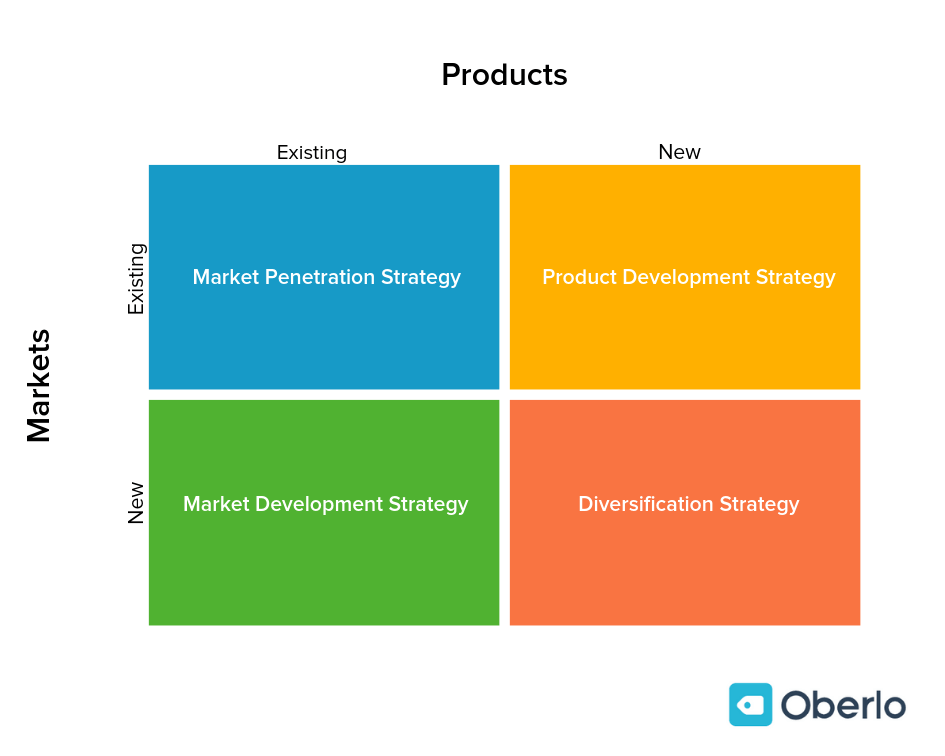
To paint a better picture of each of these five business growth strategies, let’s use the example of a made-up shoe company called Nu Shu.
Nu Shu sells handmade sneakers, and its current biggest audience is millennials.
Market Penetration
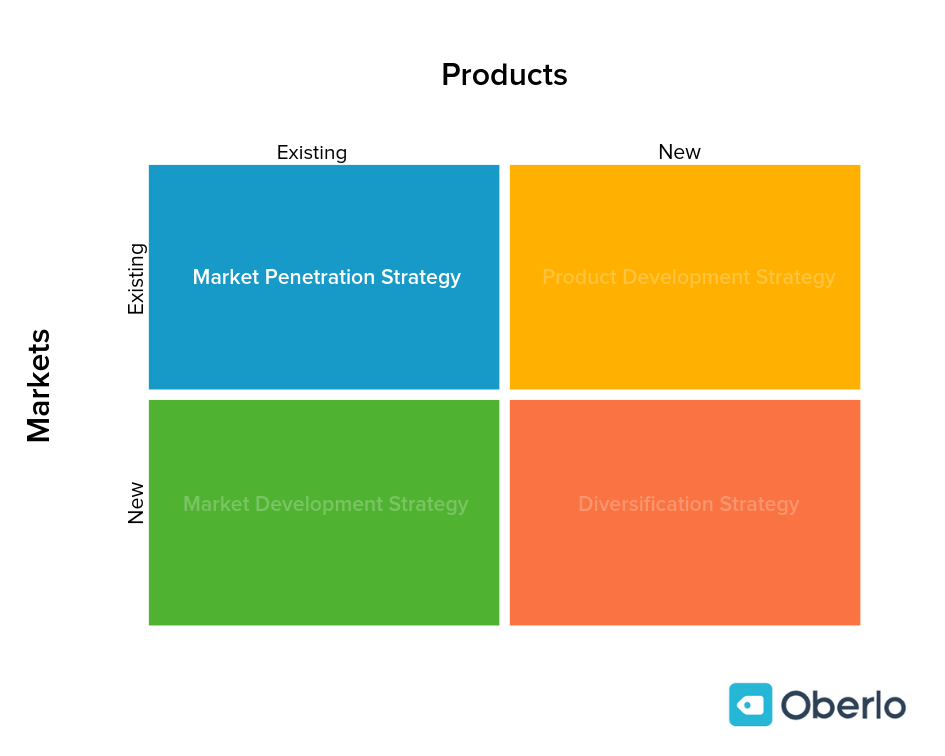
One of the most common business growth strategies, market penetration is an internal growth strategy that involves increasing your market share (or essentially getting more customers from your current market) with the products and services you already have.
Consider the example of Nu Shu: A market penetration strategy would involve trying to reach more millennials to buy the company’s existing sneaker collection.
You can do this in several ways. Here are a few ideas:
- Ramp up any of your existing marketing efforts
- Start new marketing tactics or expand to new marketing channels
- Tweak your strategy to match your competitors
- Lower the price of your offerings to take business from competitors
Market Development
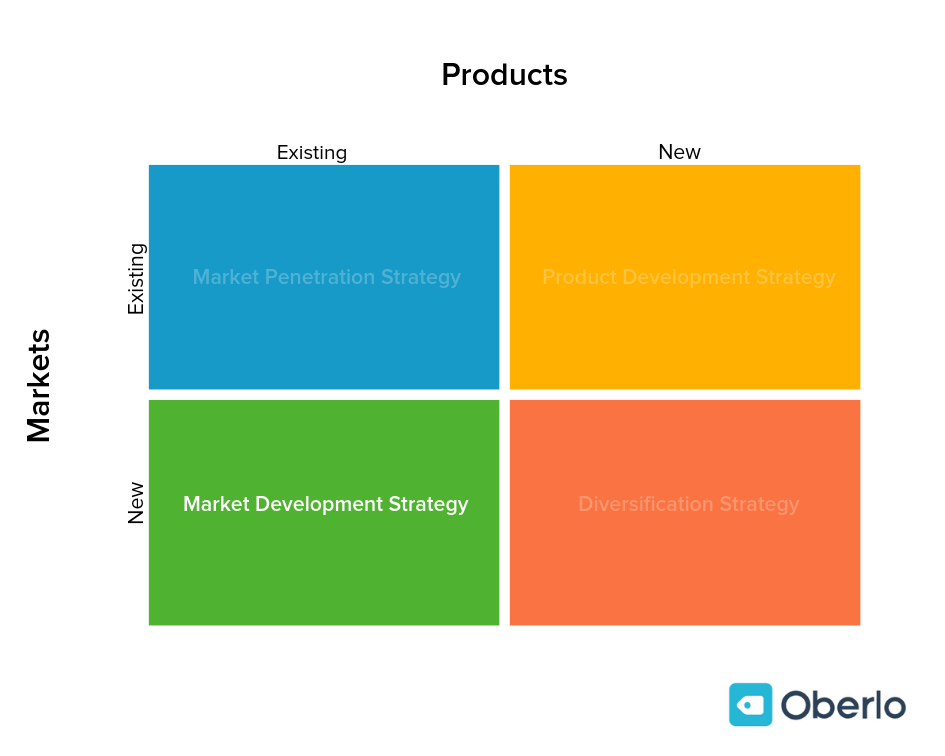
Market development, also called market expansion, is an internal growth strategy that involves selling your current offerings to a new market.
Building on the Nu Shu example, a market expansion strategy could be trying to sell those same handmade sneakers to a different market, like Gen Z.
Naturally, this would involve tweaking the company’s marketing and sales strategies to appeal to this different audience without losing appeal in the eyes of its existing millennial audience.
Product Development
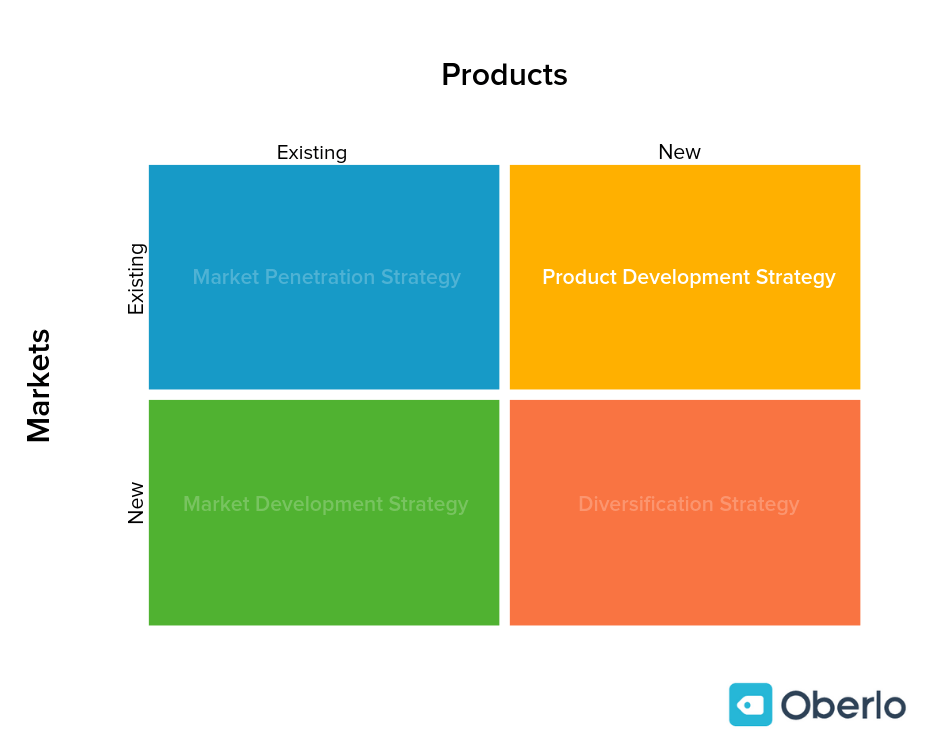
Product development, also called product expansion, is another internal growth strategy that involves expanding or developing your product line in order to make more sales in your existing market.
Product expansion for Nu Shu might be adding a new line of sneakers to meet a different need for its millennial audience, adding extra features to an existing sneaker, or introducing sandals to its shoe inventory.
If you own a dropshipping store, a simple product development strategy could be adding new products in your niche or related niches until you find something your audience likes.
Diversification
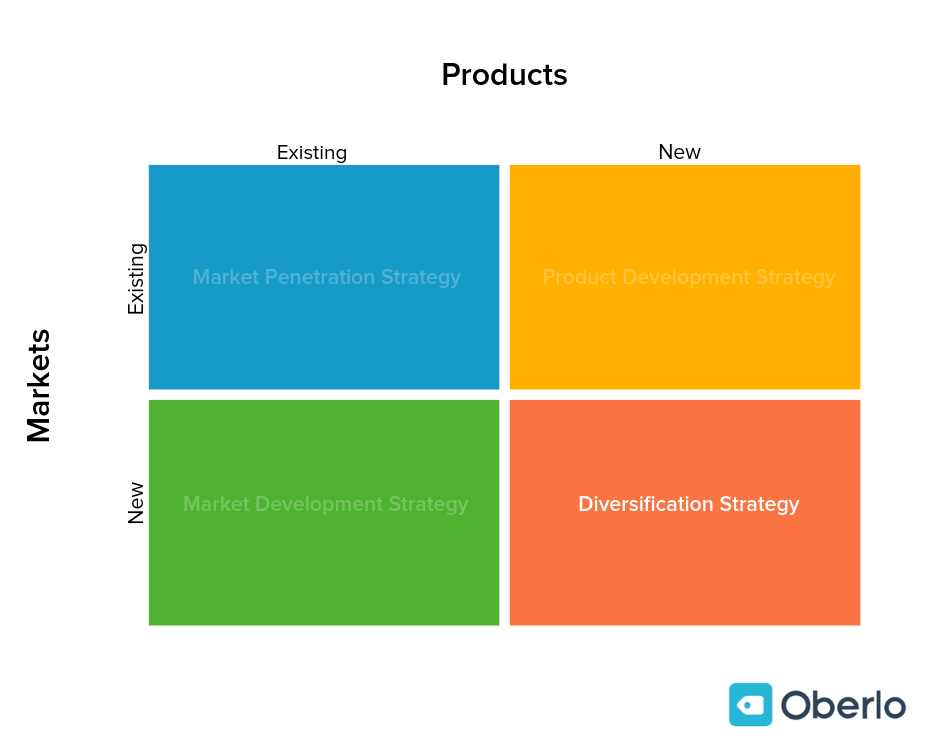
Diversification is an internal growth strategy that comes with some big risks because it’s essentially selling new products to new markets – a double dose of uncertainty.
Say that Nu Shu decides to sell handmade socks to the Gen Z market. You can see how this can be tricky if they don’t have any experience selling socks, or selling to Gen Z.
This is why diversification isn’t recommended as one of the go-to small business growth strategies. If you don’t have a lot of experience in certain markets, on top of not having extra resources to burn, it’s better to try a “safer” approach to grow your business.
Acquisition
Acquisition is an external growth strategy in which you purchase another company to expand your operations. This can be virtually any kind of company that aligns with your long-term business growth plan and goals.
Nu Shu could decide to buy an entity like:
- A competitor sneaker company that already has a strong millennial base
- An adjacent brand that already has a high-performing line of handmade socks or a strong base of Gen Z customers
- A company that can advance its quality or operations, like the one with an awesome patented shoe sole or better and faster manufacturing capabilities
How to Grow a Business
A successful growth strategy involves more than simply choosing a direction for your business to follow. A roadmap describing your long-term growth goals and an action plan for achieving them is also needed. Below are a few tips to help get you started.
- Map out your high-level growth goals
If you’re keen to supercharge your company’s growth, consider starting out with ambitious, high-level growth goals.
Of course, goal setting is a common practice in the world of business, but with high-level growth goals, you take it a step further.
Essentially, you map out goals that take a five- to ten-year commitment, but every goal is tangible, exciting, and something every stakeholder “gets” without requiring a detailed explanation.
How many people do you see yourself hiring in the next ten years? How many customers do you expect to gain by that time? How much revenue do you expect your business to generate?
Put limitations aside for a while and let your imagination take the lead; your growth goals should be seemingly unattainable and overly ambitious.
Take a look at this hypothetical example:
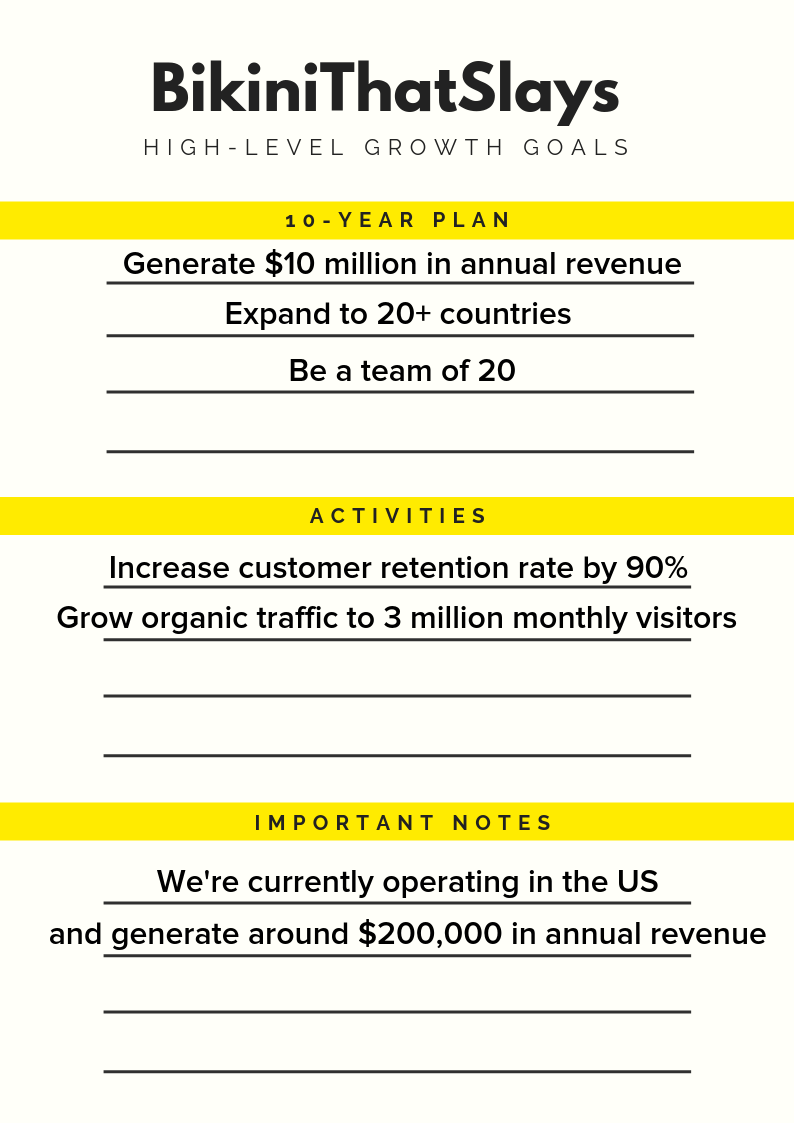
At ten years old, the brand in question expects to generate $10 million in annual revenue, and it expects to achieve that figure with a team of 20. It has also highlighted the extent of market expansion required to get there. In addition, the brand has listed out the key activities it needs to undertake in order to achieve its targets.
For most growth goals, you don’t have to worry about the current state of your business. You just need to map them out in a quantifiable manner so that it’s easy to devise a strategy that helps make them attainable.
- Identify the key metrics for those goals
For every growth goal, there is a set of core metrics that helps identify whether or not your business will be able to achieve that goal. In most instances, the metrics will have a direct correlation with your company’s revenue and customer acquisition goals.
For example, if we talk about the ride-sharing company, Uber, one of its core metrics will be the number of trips made. Why? Because it has a direct influence on the firm’s bottom line. If more trips are being completed, and that number is continuously increasing, it means that more customers are converting and therefore contributing to Uber’s overall revenue.
You’ll also need to determine your current baseline for these metrics, so you can figure out what steps you’ll need to take to achieve business growth.
In the hypothetical example from the previous point, we determined that one of the company’s growth goals was to generate $10 million in revenue and one of the steps to achieving that goal was to grow organic traffic to 3 million monthly visitors.
So, if we are to determine the key metrics for the growth goals of BikiniThatSlays, we can create annual baselines around organic traffic and retention rates.
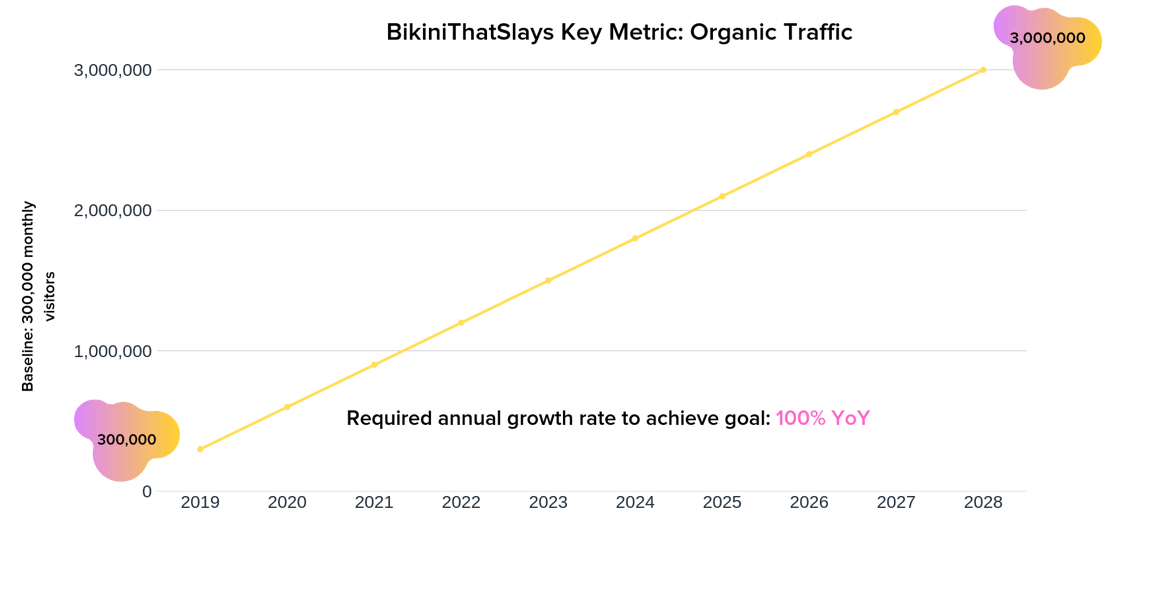
As you can see, the business needs to grow its organic traffic by 100 percent year-over-year for the next ten years to get to 3 million monthly visitors and consequently grow its annual revenue.
When building your growth strategy, remember to figure out the key metrics for your growth goals, and how your baselines will need to change in order to attain meet those long-term targets.
- Create a business growth plan around your findings
Once you’ve identified your growth goals and their key metrics, the next step is to create a plan that makes it easier to visualize the journey toward achieving those goals within your growth strategy. The best growth plans are a combination of strategy and specific measures to take for implementing that strategy to help fulfil your business objectives.
If we continue with the example of BikiniThatSlays, the growth plan would highlight the essential steps the business needs to take to increase its organic traffic and customer retention rate, which have been identified as leading indicators of business growth.
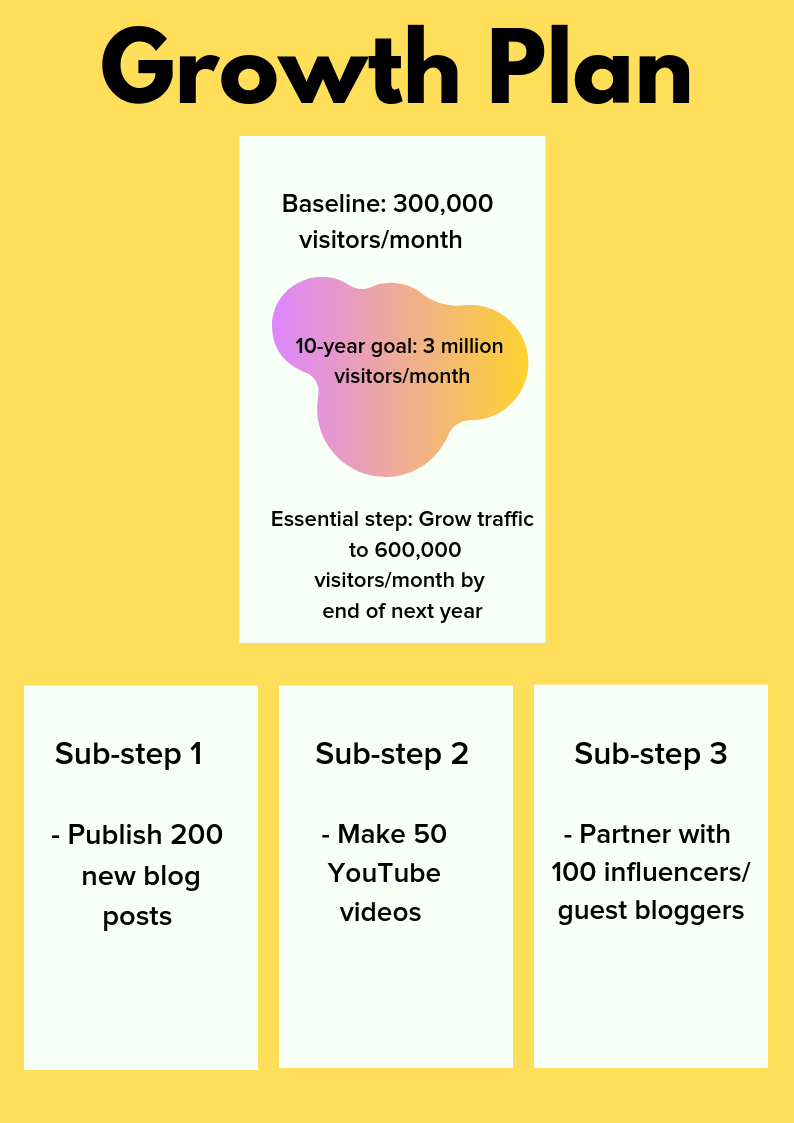
To achieve its ten-year traffic goal of 3 million monthly visitors, for instance, the business will need to scale its organic traffic to 600,000 visitors a month. The growth plan, therefore, outlines the sub-steps that BikiniThatSlays needs to take to hit that traffic figure.
Because there are multiple ways to drive organic traffic to a website, this aspect of the company’s growth strategy includes all the individual measures the business can take to meet its traffic goal, including publishing new blog posts, making YouTube videos, and partnering with influencers or guest bloggers.
While putting together your own growth plan, make sure to list all the steps you can take at a smaller scale to influence your primary growth goals in a positive manner. In addition, conduct a quarterly assessment of your progress to ensure you are on the right path and continuously fueling your growth strategy.
Growth Strategy Examples
Here are some growth strategy examples from companies that have achieved exponential growth over the years:
Growth Strategy: Diversification
When it comes to fashion, apparel can become yesterday’s news as soon as it hits Instagram, so what the Black Milk Clothing brand did is completely neglect the conventions of the industry – by not following trends or seasons and not even attending fashion parades.
Instead, the brand follows the internal growth strategy of diversification by making leggings, swimsuits, and dresses featuring popular movies, franchises and comics. It also pumps out several new designs each month, and the majority of those articles are based around what’s popular with the company’s prospective customers.
In terms of marketing, Black Milk Clothing lets its community spread the word about its business. For example, you’ll find tons of user-generated content if you search up the hashtag #blackmilkclothing on Instagram. Moreover, there’s a buy, sell, and swap Facebook group that’s exclusively dedicated to buyers, sellers, and exchangers of Black Milk apparel.
Today, Black Milk Clothing is a multimillion-dollar company, with its unique designs being the main catalyst for the company.
Growth Strategy: Product Development
The on-demand delivery service, Postmates, reached 5 million monthly deliveries last year. It also launched a new feature that lets people within the same locality pool their orders, called Postmates Party.
With growing demand, the company has focused on creating products that are easy to use and highly accessible. At the same time, it gathered funding, raising over $670 million in venture capital funding. But to keep innovating its products, Postmates also had to scale its growth team.
According to Postmates’ VP of Growth Siqi Chen, the company had a scrappy, hard-working team of employees who made the most of the resources available, but it was a massive challenge to make growth scale without product and engineering support. So, the team shifted to include product and engineering personnel at every level. Today, the company’s growth team has multiple arms of its own: User Acquisition, Growth Product, and Growth Marketing.
By empowering its team to lead from the front, Postmates created a growth plan that’s likely to scale with its business.
Growth Strategy: Market Penetration
ConvertKit’s founder Nathan Barry experimented with multiple growth strategies during the first three years of introducing his email marketing solution for bloggers, but what stood out was his direct communication with prospective clients.
With the help of personalized emails, Barry discovered that people loved the concept of ConvertKit, but it was very hard for them to consider making a switch – all of their data and information were synced to their existing tools. So, he built a “concierge migration service.”
Once a customer signs up for the service, ConvertKit would literally dive deep into WordPress and AWeber, whichever tool the blogger was using, scrape out everything and load the customer’s data into ConvertKit. Within a year and a half of using this strategy, the company was generating $125,000 in monthly recurring revenue, which has now passed the $1 million mark thanks to the hard work put in by the ConvertKit team.
Every strategy discussed above is aligned with a vision – some follow the classic market penetration strategy, while others think outside the box. Regardless of the approach, there’s something you can learn from each example to apply to your own business.
Grow Your Business the Smart Way
While it can be easy to go all-in on a promising idea, the best way to grow your business is to research, plan, execute, and iterate.
The name of the game here is tailoring your growth strategy to the unique aspects of your industry, niche, and business, and carefully tracking and analyzing your performance along the way.
When you’re focused on incremental growth, you’ll likely have much more control over the process – and it’ll be safer than if you were to throw all of your proverbial marbles into one basket.
Which business growth strategies have you found success with?
Let us know in the comments below!






